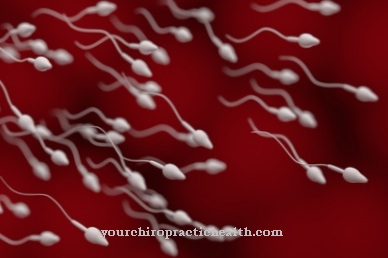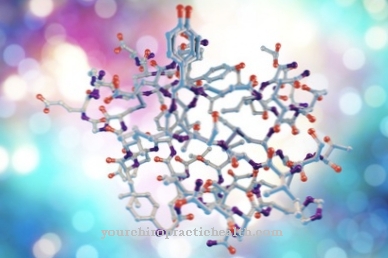The Blood clotting describes the chemical change in blood from a liquid to a solid state. This is primarily used to close the wound, but blood clotting can also occur in other parts of the body.
What is the clotting?

If there is blood in the bloodstream, it is liquid and remains in this state. Various blood components are there, among other things, to initiate blood clotting when necessary. If the blood comes into contact with an open wound, the process of blood clotting starts immediately. The smaller and more harmless the wound, the faster it will close again.
When blood clots, a kind of network is created in which blood platelets (thrombocytes) get caught and form an increasingly thick, solid and drying layer through which fresh blood can no longer penetrate to the outside. On the outside, a scar is created that protects the wound from infection and gives it time to recreate new skin and to close in the long term.
Blood clotting is a basic function of the human body, which can also occur in the internal organs in the event of injuries. However, larger, severe wounds or life-threatening injuries cannot block the blood clotting, which is why they are also dangerous.
Function & task
The most important component of blood for blood clotting is fibrin. It is a sticky part of the blood that covers the wound like a fine mesh. This happens within a very short time after the injury, since fibrin is always present in the blood. The remnants of this fibrin network can sometimes still be seen as a white border on old scars.
Because fibrin is sticky and forms a mesh, red blood platelets get caught in it on their way past the wound. The more large platelets that are caught in the fibrin network, the less blood can penetrate the wound to the outside. The upper layers of the clotted blood eventually dry out in the air and form a visibly red wound closure.
The main purpose of blood clotting is to close external and internal wounds. These are thus well protected against infections and fresh blood can no longer escape. While the scab of clotted blood shields the wound from the outside, new skin will soon form underneath. If this has matured so far that there is no longer a wound, it pushes the scab off from below and the injury is healed.
If there were no blood clotting, every bleeding wound, no matter how small, would be a potentially life-threatening threat to humans, since blood loss would never end without blood clotting.
The infection protection provided by the clotted blood of the wound is also valuable. Without this closure to the outside, there would be a very high risk of infection with every wound, as it would remain open and there would be no barrier in the form of the dried scab against dirt and pathogens that want to penetrate from the outside.
Illnesses & ailments
In the form of a rare hereditary disease, blood coagulation does not work at all for some people: it is the hemophilia that almost exclusively affects men. Every tiny wound becomes a life-threatening injury for hemophiliacs because their blood is unable to clot. Even small injuries keep bleeding this way.
In some wounds, the blood coagulates very quickly despite the soiling of the wound, even before it can be cleaned. Rapid blood clotting causes dirt particles or pathogens to become trapped in the wound and can cause infections.
The most common wound infections result from injuries in a dirty, sterile environment. But if they remain superficial and are treated quickly enough, they usually do not spread. In the worst case, the inclusion of dirt and germs can lead to spreading and a wide variety of diseases, from a purulent wound to dangerous infections such as tetanus.
Blood clotting can also be dangerous in the case of internal injuries. These occur in accidents, explosions and other accidents and are sometimes not noticed at all or at least not noticed for a long time. Some of the blood that escapes from the inner wound coagulates, but the coagulated particles cannot close the wound and eventually get into the bloodstream.
They are known as thrombi. They are dangerous because they close smaller vessels or get caught in larger vessels and block them dangerously. This can lead to life-threatening consequences, in the worst case any help comes so late. If they have already arisen, they have to be removed from the bloodstream with a small operation.
Blood coagulation only tries to close internal wounds, but due to the size of such injuries it fails and becomes a danger. Therefore, even after a minor accident, a detailed physical examination of everyone involved is important in order to properly treat internal injuries and to rule out the risk of thrombi.
Nowadays, blood type tests are done during blood transfusions. The reason for this is that blood coagulates even if it comes into contact with the "wrong" blood group. Although the exact chemical process is somewhat different from normal blood coagulation, clumping also occurs here - which must be avoided at all costs.



.jpg)























